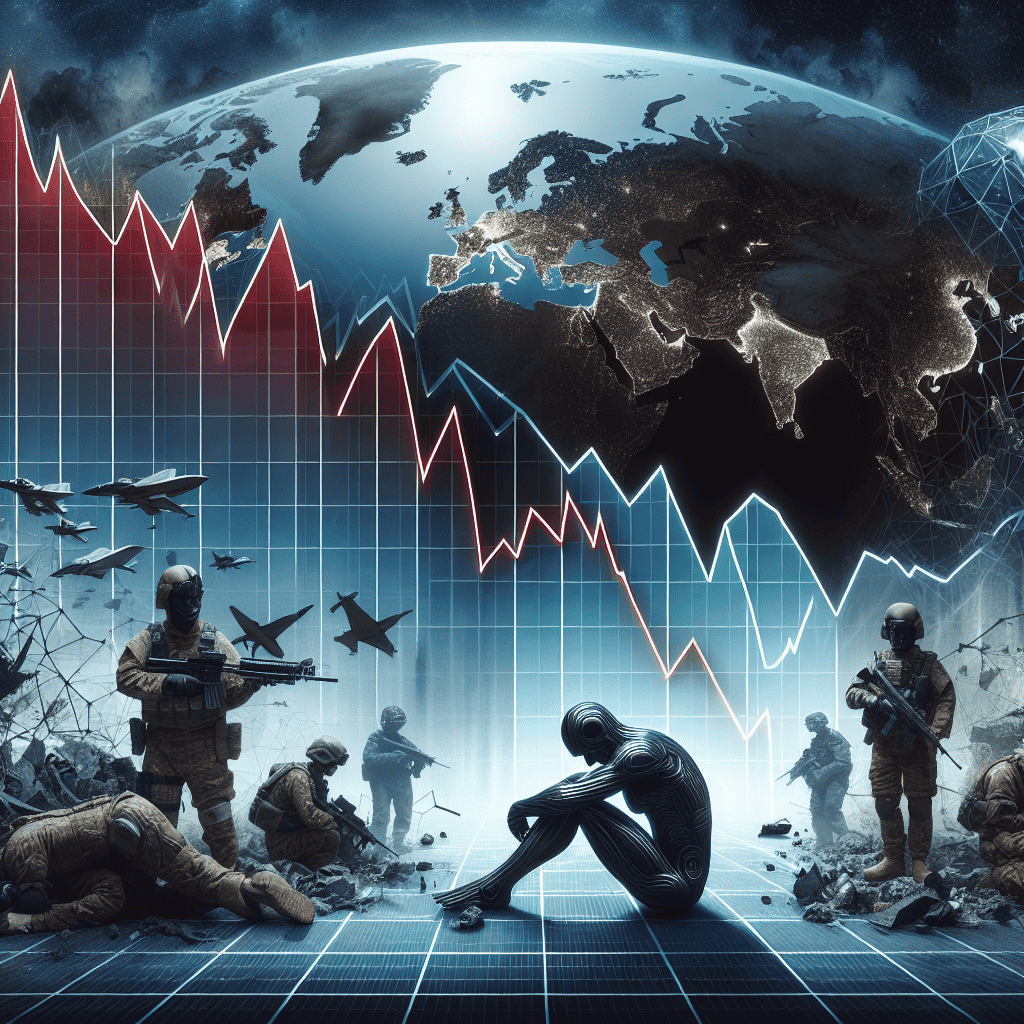“Market Shock: Unraveling the 26% Dive of a Defense Giant Amidst Rising Global Tensions”
Introduction
In a surprising turn of events, shares of a prominent defense company have plummeted by 26%, even as global tensions continue to escalate. This unexpected decline has left investors and market analysts puzzled, given the typically robust performance of defense stocks during periods of geopolitical instability. The drop in stock value can be attributed to a combination of factors, including disappointing quarterly earnings, unexpected project delays, and increased competition within the defense sector. Additionally, regulatory challenges and shifts in government defense spending priorities have further compounded the company’s struggles. As the market reacts to these developments, stakeholders are closely monitoring the situation to assess the long-term implications for the company’s financial health and strategic positioning in an increasingly volatile global landscape.
Market Overreaction: Understanding Investor Behavior
In the complex world of financial markets, investor behavior often defies conventional logic, particularly when it comes to the performance of defense stocks amid global tensions. Recently, a prominent defense stock experienced a precipitous 26% decline, a surprising development given the current geopolitical climate. To understand this phenomenon, it is essential to delve into the intricacies of market overreaction and the factors that drive investor sentiment.
At first glance, one might assume that escalating global tensions would bolster defense stocks, as nations typically ramp up military spending in response to perceived threats. However, the stock market is not solely driven by rational assessments of geopolitical events. Instead, it is a dynamic ecosystem influenced by a myriad of factors, including investor psychology, market speculation, and broader economic conditions. In this context, the recent decline of the defense stock in question can be attributed to a confluence of these elements, rather than a straightforward reaction to global tensions.
One key factor contributing to the stock’s decline is the phenomenon of market overreaction. Investors, driven by fear or exuberance, often respond disproportionately to news events, leading to significant price fluctuations. In this case, the defense stock may have been subject to an overreaction triggered by a combination of negative news reports, such as disappointing earnings results or unexpected changes in government contracts. These developments can create a ripple effect, prompting investors to sell off shares in anticipation of further declines, thereby exacerbating the stock’s downward trajectory.
Moreover, the broader economic environment plays a crucial role in shaping investor behavior. In times of economic uncertainty, investors may become more risk-averse, opting to divest from sectors perceived as volatile or unpredictable. Despite the potential for increased defense spending, concerns about inflation, interest rate hikes, and global supply chain disruptions can overshadow the perceived benefits of holding defense stocks. Consequently, investors may choose to reallocate their portfolios towards more stable assets, contributing to the decline of the defense stock in question.
Additionally, it is important to consider the impact of market speculation and short-term trading strategies. In today’s fast-paced financial markets, algorithmic trading and speculative investments can amplify price movements, leading to heightened volatility. Traders seeking to capitalize on short-term price fluctuations may engage in practices such as short selling, further driving down the stock’s value. This speculative activity can create a self-fulfilling prophecy, as declining stock prices fuel further selling pressure.
Furthermore, investor sentiment is often influenced by broader market trends and sector-specific dynamics. In recent years, there has been a growing emphasis on sustainable and socially responsible investing, with many investors prioritizing environmental, social, and governance (ESG) criteria. This shift in investment priorities may lead some investors to divest from defense stocks, which are often scrutinized for their involvement in military activities. As a result, the defense sector may face additional headwinds, contributing to the stock’s decline.
In conclusion, the 26% drop in the defense stock’s value, despite global tensions, underscores the complexity of market dynamics and investor behavior. While geopolitical events undoubtedly play a role in shaping market trends, it is the interplay of psychological, economic, and speculative factors that ultimately drives stock performance. By understanding these underlying forces, investors can better navigate the intricacies of the financial markets and make informed decisions in an ever-evolving landscape.
Earnings Miss: Analyzing the Financial Shortfall
In the complex world of defense stocks, where geopolitical tensions often drive market dynamics, it is not uncommon for companies to experience fluctuations in their stock prices. However, the recent 26% plunge of a prominent defense stock has raised eyebrows, particularly given the current global climate of heightened military and security concerns. To understand this unexpected downturn, it is essential to delve into the company’s recent earnings report, which revealed a significant financial shortfall that caught investors off guard.
At the heart of this decline lies an earnings miss that was more pronounced than analysts had anticipated. Despite the company’s strong market position and a robust portfolio of defense contracts, the latest quarterly results fell short of expectations, leading to a sharp sell-off. The company’s revenue figures, while still substantial, did not meet the optimistic projections set by market analysts. This discrepancy between expected and actual performance can be attributed to several key factors that have impacted the company’s financial health.
One of the primary reasons for the earnings miss is the delay in the execution of several high-profile defense contracts. These delays, often due to bureaucratic hurdles and extended negotiation periods, have resulted in a slower-than-expected revenue stream. Consequently, the anticipated cash flow from these contracts has not materialized within the projected timeline, creating a gap in the company’s financial performance. Furthermore, the company has faced increased competition from emerging players in the defense sector, which has put pressure on its pricing strategies and profit margins.
In addition to these operational challenges, the company has also been grappling with rising costs. The defense industry is heavily reliant on advanced technology and skilled labor, both of which have seen significant cost increases in recent years. The company has had to invest heavily in research and development to maintain its competitive edge, further straining its financial resources. These escalating costs have eroded the company’s profitability, contributing to the earnings miss that has alarmed investors.
Moreover, the company’s management has acknowledged that certain strategic decisions have not yielded the expected outcomes. For instance, investments in specific international markets have not generated the anticipated returns, partly due to geopolitical instability and shifting defense priorities in those regions. This has led to a reassessment of the company’s global strategy, which, while necessary, has introduced an element of uncertainty that investors typically shy away from.
Despite these challenges, it is important to note that the company’s long-term prospects remain intact. The defense sector continues to be a critical component of national security for many countries, and the demand for advanced defense systems is unlikely to diminish. However, the current earnings miss serves as a reminder of the volatility inherent in the industry and the need for companies to adapt swiftly to changing market conditions.
In conclusion, while the 26% drop in this defense stock may seem alarming at first glance, it is a reflection of a complex interplay of factors that have temporarily impacted the company’s financial performance. By addressing the operational inefficiencies and recalibrating its strategic focus, the company has the potential to recover and regain investor confidence. As the global landscape continues to evolve, the ability to navigate these challenges will be crucial for the company’s future success.
Supply Chain Disruptions: Impact on Production and Delivery
In recent months, the defense sector has been under intense scrutiny as geopolitical tensions continue to escalate globally. Investors typically view defense stocks as a safe haven during such times, expecting them to benefit from increased government spending on military capabilities. However, one particular defense stock has defied this expectation, plummeting 26% despite the prevailing global tensions. The primary reason behind this unexpected downturn lies in the significant supply chain disruptions that have severely impacted the company’s production and delivery capabilities.
To understand the situation, it is essential to consider the intricate nature of supply chains in the defense industry. These supply chains are often complex, involving numerous suppliers and subcontractors spread across different regions. The recent disruptions have been multifaceted, stemming from a combination of factors such as geopolitical instability, trade restrictions, and the lingering effects of the COVID-19 pandemic. These disruptions have led to delays in the procurement of critical components, thereby stalling production lines and affecting the timely delivery of defense products.
Moreover, the defense industry is heavily reliant on specialized materials and components that are not easily substitutable. This dependency exacerbates the impact of supply chain disruptions, as finding alternative suppliers or materials is not always feasible. Consequently, the affected company has faced significant challenges in maintaining its production schedules, leading to missed deadlines and contractual penalties. These operational setbacks have not only tarnished the company’s reputation but have also raised concerns among investors about its ability to fulfill future contracts.
In addition to the immediate operational challenges, the financial implications of these supply chain disruptions are profound. The company has incurred increased costs as it attempts to mitigate the impact of delays by expediting shipments and sourcing alternative materials at premium prices. These additional expenses have eroded profit margins, further contributing to the decline in the company’s stock value. Furthermore, the uncertainty surrounding the resolution of these supply chain issues has led to a cautious outlook from analysts, who have revised their earnings forecasts downward.
While the company is actively working to address these challenges, the path to recovery is fraught with obstacles. Efforts to diversify the supplier base and enhance supply chain resilience are underway, but these initiatives require time and investment. In the interim, the company must navigate the delicate balance between meeting current obligations and investing in long-term solutions. This balancing act is critical to restoring investor confidence and stabilizing the stock price.
Despite the current setbacks, it is important to recognize that the defense industry remains a vital component of national security, and demand for defense products is unlikely to diminish in the long term. As such, the affected company has the potential to rebound once supply chain issues are resolved and production normalizes. However, the experience serves as a stark reminder of the vulnerabilities inherent in global supply chains and the need for companies to proactively manage these risks.
In conclusion, the 26% decline in this defense stock, despite global tensions, underscores the significant impact of supply chain disruptions on production and delivery. The company’s challenges highlight the importance of supply chain resilience in maintaining operational efficiency and financial stability. As the company works to overcome these obstacles, its experience offers valuable lessons for the broader defense industry in navigating the complexities of global supply chains.
Regulatory Challenges: Navigating New Defense Policies

In recent months, the defense sector has been under intense scrutiny as geopolitical tensions continue to rise globally. Despite the heightened demand for military equipment and technology, one particular defense stock has experienced a significant decline, plummeting 26%. This unexpected downturn can be attributed to a series of regulatory challenges that have emerged, complicating the landscape for defense companies as they navigate new policies and compliance requirements.
The defense industry is inherently intertwined with government regulations, given its critical role in national security. However, recent shifts in defense policies have introduced a new layer of complexity for companies operating in this sector. These changes are largely driven by evolving international relations and the need for governments to adapt their defense strategies accordingly. As a result, defense firms are now facing increased pressure to align with these new regulatory frameworks, which can be both time-consuming and costly.
One of the primary regulatory challenges impacting the defense sector is the tightening of export controls. Governments around the world are becoming more cautious about the transfer of military technology and equipment, particularly to regions experiencing conflict or instability. This has led to stricter licensing requirements and more rigorous scrutiny of defense contracts. For companies heavily reliant on international sales, these restrictions can significantly hinder their ability to secure new business opportunities, thereby affecting their financial performance.
Moreover, the introduction of new compliance standards has further complicated the operational landscape for defense firms. These standards often require substantial investments in compliance infrastructure and personnel, diverting resources away from core business activities. For smaller companies, in particular, the financial burden of meeting these requirements can be overwhelming, potentially leading to reduced competitiveness in the market.
In addition to export controls and compliance standards, defense companies are also grappling with the challenge of cybersecurity regulations. As military technology becomes increasingly digitalized, the risk of cyber threats has grown exponentially. Governments are now mandating stricter cybersecurity measures to protect sensitive defense information from potential breaches. While these measures are essential for national security, they also impose additional costs and operational challenges on defense firms, which must continuously update their systems and protocols to stay compliant.
Furthermore, the defense sector is facing increased scrutiny regarding ethical considerations and human rights implications. Governments and international organizations are placing greater emphasis on ensuring that defense products are not used in ways that violate human rights or contribute to humanitarian crises. This has led to more stringent due diligence processes and the need for defense companies to demonstrate their commitment to ethical practices. Navigating these ethical considerations requires a delicate balance, as companies must ensure compliance without compromising their business objectives.
In conclusion, the 26% decline in this defense stock can be largely attributed to the myriad of regulatory challenges that have emerged in response to new defense policies. As companies strive to navigate these complex regulations, they must also contend with the financial and operational implications that accompany them. While the demand for defense products remains strong amid global tensions, the ability of companies to adapt to these regulatory changes will be crucial in determining their long-term success. As the defense sector continues to evolve, firms must remain agile and proactive in addressing these challenges to maintain their competitive edge in an increasingly regulated environment.
Competitive Pressures: Emerging Rivals in the Defense Sector
In recent months, the defense sector has been under intense scrutiny as geopolitical tensions continue to escalate across various regions of the world. Despite the heightened demand for military equipment and technology, one particular defense stock has experienced a surprising downturn, plummeting 26% in value. This unexpected decline can be attributed to the increasing competitive pressures from emerging rivals within the defense industry, which have begun to reshape the landscape of this traditionally stable sector.
To understand the dynamics at play, it is essential to consider the broader context of the defense industry. Historically dominated by a few major players, the sector has seen a significant influx of new entrants, driven by technological advancements and shifting defense priorities. These emerging rivals are not only challenging the established giants but are also introducing innovative solutions that cater to the evolving needs of modern warfare. Consequently, traditional defense companies are finding it increasingly difficult to maintain their market share and profitability.
One of the primary factors contributing to the rise of these new competitors is the rapid pace of technological innovation. Startups and smaller firms, often more agile and adaptable than their larger counterparts, are leveraging cutting-edge technologies such as artificial intelligence, cybersecurity, and unmanned systems to develop advanced defense solutions. These innovations are not only more cost-effective but also offer enhanced capabilities, making them highly attractive to defense ministries worldwide. As a result, established defense companies are facing mounting pressure to innovate and adapt, a challenge that some have struggled to meet.
Moreover, the changing nature of global conflicts has also played a role in reshaping the defense sector. With an increasing focus on asymmetric warfare and cyber threats, traditional defense products such as tanks and fighter jets are no longer the sole priority for military forces. Instead, there is a growing demand for versatile and technologically advanced systems that can address a wide range of security challenges. This shift in priorities has opened the door for new entrants to capture a significant portion of the market, further intensifying the competitive landscape.
In addition to technological advancements and changing defense priorities, geopolitical factors have also contributed to the rise of new competitors. As countries seek to bolster their domestic defense industries and reduce reliance on foreign suppliers, they are investing heavily in local companies and fostering innovation within their borders. This trend has led to the emergence of new players in regions such as Asia and the Middle East, which are now competing on a global scale. These regional competitors are not only challenging established Western defense firms but are also driving down prices, thereby exerting additional pressure on profit margins.
In light of these developments, it is clear that the defense sector is undergoing a significant transformation. Established companies must navigate this evolving landscape by embracing innovation, forming strategic partnerships, and diversifying their product offerings to remain competitive. Failure to do so could result in further declines in market share and financial performance, as evidenced by the recent 26% drop in the stock value of one such company. As the defense industry continues to evolve, it will be crucial for traditional players to adapt to the new realities of the market, lest they be left behind by their more nimble and innovative rivals.
Geopolitical Shifts: Changing Defense Priorities Globally
In recent months, the defense sector has been under intense scrutiny as geopolitical tensions continue to escalate across various regions. Despite the heightened demand for military capabilities, one particular defense stock has experienced a surprising downturn, plummeting 26% in value. This unexpected decline can be attributed to a confluence of factors that have reshaped global defense priorities, leading investors to reassess their positions.
To begin with, the shifting geopolitical landscape has prompted nations to reevaluate their defense strategies. Traditionally, defense spending has been heavily influenced by the need to counter conventional threats. However, the emergence of new challenges, such as cyber warfare and asymmetric threats, has necessitated a reallocation of resources. Consequently, defense companies that have not adapted to these evolving demands find themselves at a disadvantage. The company in question, despite its strong legacy in traditional defense systems, has been slow to pivot towards these new domains, resulting in a loss of investor confidence.
Moreover, the global defense market is increasingly influenced by technological advancements. Nations are prioritizing investments in cutting-edge technologies such as artificial intelligence, unmanned systems, and advanced surveillance capabilities. Companies that have successfully integrated these technologies into their product offerings are witnessing robust growth. In contrast, those that remain reliant on outdated systems are struggling to maintain their market share. The defense stock in question has been criticized for its lack of innovation, further exacerbating its decline.
In addition to technological shifts, economic factors have also played a significant role in the stock’s downturn. The global economy is currently facing a period of uncertainty, with inflationary pressures and supply chain disruptions affecting various industries. Defense companies are not immune to these challenges, as rising costs and delays in production can impact profitability. The company in question has reported several project delays and cost overruns, which have contributed to its declining stock value. Investors, wary of these financial setbacks, have opted to divest, seeking more stable opportunities elsewhere.
Furthermore, geopolitical alliances and partnerships are undergoing significant transformations. As nations forge new alliances and strengthen existing ones, defense contracts are increasingly influenced by diplomatic considerations. Companies that have established strong international partnerships are better positioned to secure lucrative contracts. Unfortunately, the defense stock in question has faced difficulties in expanding its global footprint, limiting its access to international markets. This lack of diversification has made it vulnerable to regional instabilities and shifts in defense spending priorities.
Lastly, regulatory changes and government policies have also impacted the defense sector. Governments worldwide are implementing stricter regulations on defense exports, aiming to prevent the proliferation of advanced military technologies. These regulations can hinder a company’s ability to capitalize on international sales, affecting its revenue streams. The defense stock in question has faced challenges in navigating these regulatory landscapes, further contributing to its decline.
In conclusion, the 26% drop in this defense stock’s value, despite global tensions, can be attributed to a combination of factors. The company’s inability to adapt to changing defense priorities, coupled with economic challenges and regulatory hurdles, has eroded investor confidence. As the geopolitical landscape continues to evolve, defense companies must remain agile and innovative to thrive in this dynamic environment. Investors, in turn, must carefully assess these factors when making decisions in the defense sector, recognizing that traditional metrics may no longer suffice in evaluating potential opportunities.
Investor Sentiment: The Role of Market Speculation
In the complex world of financial markets, investor sentiment often plays a pivotal role in determining the trajectory of stock prices. This phenomenon was recently observed when a prominent defense stock plummeted by 26%, despite escalating global tensions that would typically bolster the defense sector. To understand this paradox, it is essential to delve into the intricacies of market speculation and its impact on investor behavior.
At first glance, one might assume that rising geopolitical tensions would naturally lead to increased demand for defense products and services, thereby boosting the stock prices of companies within this sector. Historically, defense stocks have been perceived as safe havens during times of international conflict, as governments ramp up military spending to address security concerns. However, the recent decline in this particular defense stock underscores the complexity of market dynamics and the influence of investor sentiment.
A key factor contributing to the stock’s decline is the role of market speculation. Investors often rely on a combination of fundamental analysis and speculative insights to make informed decisions. In this case, despite the favorable macroeconomic conditions for the defense industry, speculative concerns about the company’s future performance and strategic direction may have overshadowed the broader market trends. For instance, investors might have been wary of the company’s ability to secure new contracts or effectively manage its existing projects, leading to a lack of confidence in its growth prospects.
Moreover, the stock’s decline can also be attributed to broader market trends and investor behavior. In recent years, there has been a growing emphasis on environmental, social, and governance (ESG) factors, with investors increasingly scrutinizing companies’ ethical practices and sustainability initiatives. Defense companies, by their very nature, often face challenges in aligning with ESG criteria, which can deter socially conscious investors. This shift in investor priorities may have contributed to the stock’s underperformance, as market participants reassess their portfolios in light of these evolving values.
Additionally, the influence of short-term trading strategies cannot be overlooked. In today’s fast-paced financial markets, high-frequency trading and algorithmic strategies can exacerbate stock price volatility. These trading practices often capitalize on short-term market movements, amplifying price swings and creating a feedback loop that can further erode investor confidence. As a result, even minor negative news or speculation can trigger significant sell-offs, as was likely the case with this defense stock.
Furthermore, it is important to consider the broader economic environment and its impact on investor sentiment. With concerns about inflation, interest rate hikes, and potential economic slowdowns, investors may be more risk-averse, opting to divest from sectors perceived as volatile or uncertain. This cautious approach can lead to a reallocation of capital away from defense stocks, despite their traditional role as defensive investments.
In conclusion, the 26% decline in this defense stock, despite global tensions, highlights the multifaceted nature of investor sentiment and market speculation. While geopolitical factors typically support the defense sector, a confluence of speculative concerns, ESG considerations, short-term trading dynamics, and broader economic uncertainties can significantly influence stock performance. As investors navigate these complexities, it becomes increasingly important to adopt a holistic approach, considering both macroeconomic trends and company-specific factors, to make informed investment decisions.
Q&A
1. **Question:** What is the name of the defense stock that plummeted 26%?
**Answer:** The specific name of the defense stock is not provided.
2. **Question:** What were the global tensions that might have influenced defense stocks?
**Answer:** The global tensions likely refer to geopolitical conflicts or military escalations, but specific events are not detailed.
3. **Question:** What was the primary reason for the stock’s decline?
**Answer:** The primary reason for the stock’s decline could be disappointing financial results, missed earnings expectations, or negative guidance.
4. **Question:** Did the company report any financial issues contributing to the stock drop?
**Answer:** Yes, financial issues such as lower-than-expected revenue or profit margins may have contributed.
5. **Question:** Were there any specific operational challenges mentioned?
**Answer:** Specific operational challenges like supply chain disruptions or project delays might have been factors.
6. **Question:** How did investors react to the news of the stock’s decline?
**Answer:** Investors likely reacted negatively, leading to a sell-off and the subsequent drop in stock price.
7. **Question:** Is there any indication of future recovery for the stock?
**Answer:** Future recovery might depend on the company’s ability to address financial and operational issues and improve performance.
Conclusion
The defense stock plummeted 26% despite global tensions due to a combination of factors including disappointing financial performance, such as missed earnings expectations or reduced revenue forecasts, potential operational challenges like supply chain disruptions or project delays, and possibly negative investor sentiment driven by broader market trends or sector-specific issues. Additionally, regulatory or geopolitical developments might have adversely impacted the company’s outlook, leading to a loss of investor confidence. These elements collectively overshadowed the positive influence of global tensions on defense spending, resulting in the stock’s significant decline.





